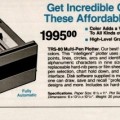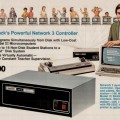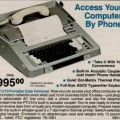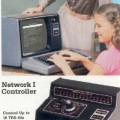TRS-80 Digitizer
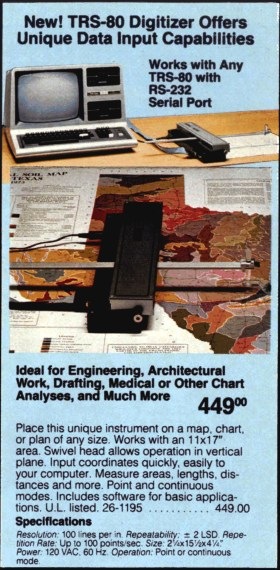
TRS-80 Digitizer from a 1982 Radio Shack catalog
The TRS-80 Digitizer (catalog number 26-1195), available in November 1981, provided a way to digitize maps, blueprints, and charts in an era before document scanners were affordable or commonly available. The Digitizer, which measured 2¼″ by 15½″ by 4¼″, cost $449.00 and connected to the TRS-80 Model I or Color Computer through the cassette port or to other TRS-80 models through the RS-232 port. (Oddly, the Model III couldn’t be connected through the cassette port like the Model I.)
The manual described the concept behind the TRS-80 Digitizer:
What exactly is a digitizer? Basically, it’s a device that describes a specific point on a sheet of paper in terms of its X-Y (Cartesian) coordinates. For example, if you didn’t have a Digitizer and you wanted to describe the location of a particular point on an 8 1/2" X 11" sheet of paper, you would need to measure how far from the left edge that point is, then how far from the top edge it is.
A digitizer does this for you. It tells you how far horizontally (the X-axis) and how far vertically (the Y-axis) that point is from the edge of the paper.
The main part of the TRS-80 Digitizer consisted of a Lucite “cursor” (with cross hairs) mounted on a “traverse arm.” It was designed to be positioned over the two-dimensional surface to be digitized. That surface was normally paper (the manual recommended that paper be taped down so it couldn’t move), but it didn’t have to be, as mentioned in the product introduction in the TRS-80 Microcomputer News:
The mobility of the cursor in its tracks will even allow you to input digital information from the pages of a book or other fairly thick object. You could easily use this unit on a light table for reading information from transparencies. And last, but not least, the active unit swivels from its base to allow you to place the unit on top of a CRT. The cursor then folds down in front of the screen, allowing you to input data directly from the screen.
There was a SEND switch on the cursor and a RESET switch on the Digitizer. The normal approach was to move the cursor to the origin (usually the upper left corner) and press the RESET switch, marking that point as 0, 0. The cursor could then be moved to important points on the surface and the SEND switch pressed at each point. Custom software could capture those coordinates, allowing accurate positions and distances between positions to be measured. Precision was good enough to allow being able to “input four discrete coordinates for the corners of the period printed by a dot matrix printer.”
The manual included several sample programs for different computer models, but it was clearly intended to be used with custom programs. The TRS-80 Digitizer was a fairly specialized piece of hardware, but one with many useful business and scientific applications.
The TRS-80 Digitizer appeared in the Radio Shack catalogs until 1984.
